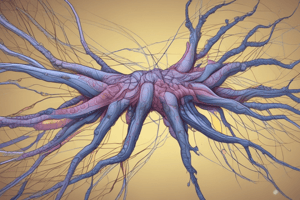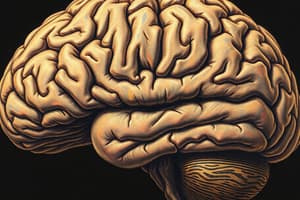Podcast
Questions and Answers
What is the part of the brain responsible for coordinating muscle movements and maintaining balance?
What is the part of the brain responsible for coordinating muscle movements and maintaining balance?
- Cerebellum (correct)
- Cerebrum
- Medulla Oblongata
- Hypothalamus
What term refers to something pertaining to muscles and nerves?
What term refers to something pertaining to muscles and nerves?
myoneural
What is the name of the neurotransmitter released at the nerve synapse?
What is the name of the neurotransmitter released at the nerve synapse?
acetylcholine
What part of the nerve cell first receives the nervous impulse?
What part of the nerve cell first receives the nervous impulse?
What are elevated portions of the cerebral cortex called?
What are elevated portions of the cerebral cortex called?
What term describes a burning sensation of pain?
What term describes a burning sensation of pain?
What is a network of interlacing nerve fibers in the peripheral nervous system called?
What is a network of interlacing nerve fibers in the peripheral nervous system called?
Which part of the brain controls the pituitary gland, water balance, and body temperature?
Which part of the brain controls the pituitary gland, water balance, and body temperature?
What are glial cells that provide support and nutrition to neurons called?
What are glial cells that provide support and nutrition to neurons called?
What is the space between nerve cells called?
What is the space between nerve cells called?
What part of the brain controls breathing, heartbeat, and blood vessel size?
What part of the brain controls breathing, heartbeat, and blood vessel size?
What term describes the inability to speak?
What term describes the inability to speak?
What is the term for a collection of spinal nerves below the end of the spinal cord?
What is the term for a collection of spinal nerves below the end of the spinal cord?
What term refers to a disease of the spinal cord?
What term refers to a disease of the spinal cord?
What is a collection of blood within the meningeal layers called?
What is a collection of blood within the meningeal layers called?
What is the abnormal sensation of tingling or prickling called?
What is the abnormal sensation of tingling or prickling called?
What is inflammation of a spinal nerve root called?
What is inflammation of a spinal nerve root called?
What type of brain tumor is highly malignant?
What type of brain tumor is highly malignant?
What does paralysis of four extremities refer to?
What does paralysis of four extremities refer to?
Cerebral aneurysm, thrombosis, or hemorrhage can be the cause of what?
Cerebral aneurysm, thrombosis, or hemorrhage can be the cause of what?
What is fainting called?
What is fainting called?
What is spina bifida associated with?
What is spina bifida associated with?
What characterizes Parkinson's disease?
What characterizes Parkinson's disease?
What is the disorder of reading, writing, and learning called?
What is the disorder of reading, writing, and learning called?
What condition describes no nervous sensation?
What condition describes no nervous sensation?
What do we call the blood-brain barrier?
What do we call the blood-brain barrier?
What type of glial cell transports water and salts from the capillaries?
What type of glial cell transports water and salts from the capillaries?
What is the portion of the brain that includes the connection of the cerebrum with the spinal cord?
What is the portion of the brain that includes the connection of the cerebrum with the spinal cord?
What is the outer region of the cerebrum that contains sheets of nerves?
What is the outer region of the cerebrum that contains sheets of nerves?
What layer of the meninges is the thick, outermost layer?
What layer of the meninges is the thick, outermost layer?
Study Notes
Nervous System Key Concepts
- Cerebellum: Coordinates muscle movements and maintains balance; located in the posterior part of the brain.
- Myoneural: Pertains to muscles and nerves, highlighting the connection between muscular and nervous systems.
- Acetylcholine: A key neurotransmitter released at nerve terminal endings, crucial for muscle activation.
- Dendrite: Part of a nerve cell that receives nervous impulses; responsible for transmitting signals to the cell body.
- Gyri: Elevated portions of the cerebral cortex, involved in higher brain functions.
- Causalgia: Describes a burning sensation of pain, often associated with nerve damage.
- Plexus: A network of interlacing nerve fibers in the peripheral nervous system that routes signals.
- Hypothalamus: Brain region controlling the pituitary gland, water balance, and body temperature regulation.
- Astrocytes: Type of glial cell in the nervous system that supports and nourishes neurons.
- Synapse: The space between nerve cells where chemical communication occurs.
- Medulla Oblongata: Governs autonomic functions such as breathing, heartbeat, and blood vessel size.
- Aphasia: A condition characterized by the inability to speak, often resulting from brain damage.
- Cauda Equina: Collection of spinal nerves at the lower end of the spinal cord, responsible for lower limb sensation and movement.
- Myelopathy: Refers to any disease of the spinal cord, affecting mobility and sensation.
- Subdural Hematoma: A collection of blood between the meningeal layers, often due to trauma.
- Paresthesia: Abnormal sensations such as tingling or prickling, typically caused by nerve dysfunction.
- Radiculitis: Inflammation of a spinal nerve root, often leading to pain and weakness.
- Glioblastoma: A highly malignant type of brain tumor originating from glial cells.
- Paraplegia: Paralysis affecting all four extremities, typically resulting from spinal injury or disease.
- Cerebrovascular Accident (CVA): Caused by cerebral aneurysm, thrombosis, or hemorrhage; also known as a stroke.
- Syncope: A medical term for fainting or temporary loss of consciousness.
- Myelomeningocele: A severe form of spina bifida involving the spinal cord and its coverings.
- Parkinson's Disease: A neurological disorder characterized by shuffling gait and tremors.
- Dyslexia: A learning disorder affecting reading, writing, and comprehension skills.
- Anesthesia: The condition resulting in no nervous sensation, often induced for surgical procedures.
- Blood-Brain Barrier: Selectively permits certain substances to pass into brain tissue while blocking others; protects the brain.
- Astrocyte: A glial cell that helps transport water and salts from capillaries to neurons, contributing to the blood-brain barrier.
- Axon: Microscopic fiber in a nerve cell that carries nervous impulses away from the cell body.
- Afferent Nerve: Carries sensory messages toward the brain and spinal cord from sensory receptors.
- Brain Stem: The lower portion of the brain connecting the cerebrum to the spinal cord; controls vital functions.
- Cell Body: Contains the nucleus of a nerve cell, essential for maintaining the cell's life.
- Arachnoid Membrane: The middle layer of the meninges, protective coverings of the brain and spinal cord.
- Autonomic Nervous System: Controls involuntary functions of the body, including actions of glands and internal organs.
- Efferent Nerve: Motor nerve that transmits messages away from the brain and spinal cord to muscles.
- Cerebrum: The largest part of the brain; responsible for higher brain functions including thought and action.
- Central Nervous System: Comprises the brain and spinal cord, central to processing information and controlling the body.
- Ependymal Cell: A type of glial cell lining the brain's ventricular system, involved in cerebrospinal fluid production.
- Cerebral Cortex: The outer region of the cerebrum, important for complex brain functions such as perception, thought, and decision-making.
- Cerebrospinal Fluid: Circulates around the brain and spinal cord, providing cushioning and support.
- Dura Mater: The thickest and outermost layer of the meninges, providing protection to the brain and spinal cord.
Studying That Suits You
Use AI to generate personalized quizzes and flashcards to suit your learning preferences.
Description
Test your knowledge of the nervous system with these flashcards from Chapter 10. Explore key terms such as cerebellum, myoneural, and neurotransmitters. Perfect for students looking to reinforce their understanding of neuroscience concepts.




